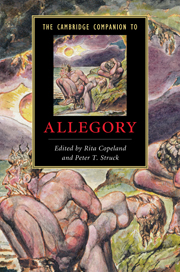Book contents
- Frontmatter
- Introduction
- Part I: Ancient foundations
- Part II: Philosophy, theology, and poetry 200 to 1200
- Part III: Literary allegory: philosophy and figuration
- Part IV: The fall and rise of allegory
- 15 Romanticism’s errant allegory
- 16 American allegory to 1900
- 17 Walter Benjamin’s concept of allegory
- 18 Hermeneutics, deconstruction, allegory
- 19 Allegory happens: allegory and the arts post-1960
- Further reading
- Index
15 - Romanticism’s errant allegory
from Part IV: - The fall and rise of allegory
Published online by Cambridge University Press: 28 January 2011
- Frontmatter
- Introduction
- Part I: Ancient foundations
- Part II: Philosophy, theology, and poetry 200 to 1200
- Part III: Literary allegory: philosophy and figuration
- Part IV: The fall and rise of allegory
- 15 Romanticism’s errant allegory
- 16 American allegory to 1900
- 17 Walter Benjamin’s concept of allegory
- 18 Hermeneutics, deconstruction, allegory
- 19 Allegory happens: allegory and the arts post-1960
- Further reading
- Index
Summary
“They look at [The Faerie Queene] as a child looks at a painted dragon, and think it will strangle them in its shining folds. This is very idle. If they do not meddle with the allegory, the allegory will not meddle with them.” William Hazlitt/ Neoclassical writers took a dim and limited view of allegory, insisting that it was most decorous when strictly iconographic and immobile, like a pictorial representation of Justice holding scales. Allegorical “persons” that move and act troubled Neoclassical strictures about the need to separate abstract figures from realist narratives or, indeed, narrative of any kind. Both Spenser's The Faerie Queene and the allegorical episode Satan, Sin and Death in Milton's Paradise Lost were common targets. When the Romantic writer Leigh Hunt suggests that The Faerie Queene is “but one part allegory, and nine parts beauty and enjoyment; sometimes an excess of flesh and blood,” he exposes a dimension of allegory that Neoclassicism rejected. The unaccommodated remainder in this equation registers what his contemporary William Hazlitt wryly suggests readers might safely ignore - the specter of allegorical figures alive and on the move. This essay charts the Romantic understanding of allegory as a genre and narrative figure that tacks between realist narratives and details and the abstractions with which allegory has long been identified. Romantic writers and artists devise allegorical figures whose unaccommodated remainder of “flesh and blood” is a striking index of their “otherness,” an excess defiant of the law of abstraction and the law of genre.
- Type
- Chapter
- Information
- The Cambridge Companion to Allegory , pp. 211 - 228Publisher: Cambridge University PressPrint publication year: 2010
- 2
- Cited by



